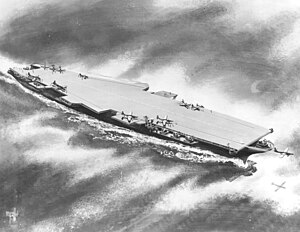USS United States (CVA 58)

Artist's rendering of the proposed USS United States handling McDonnell FH-1 Phantom fighters and Lockheed P2V-3C Neptune twin-engine bombers
|
|
| Class overview | |
|---|---|
| Name: | United States class |
| Builders: | Newport News Shipbuilding |
| Preceded by: | Midway class |
| Succeeded by: | Forrestal classs= |
| Planned: | 5 |
| Completed: | 0 |
| History | |
|
|
|
| Name: | United States |
| Ordered: | 29 July 1948 |
| Builder: | Newport News Drydock and Shipbuilding |
| Laid down: | 18 April 1949 |
| Fate: | Cancelled 23 April 1949 |
| General characteristics | |
| Class and type: | Aircraft carrier |
| Displacement: |
|
| Length: | 1,090 ft (330 m) overall, 1,030 ft (310 m) waterline, 1,088 feet (332 m) flight deck |
| Beam: | 125 ft (38 m) waterline (molded), 190 ft (58 m) flight deck |
| Draft: | 37 ft (11 m) |
| Propulsion: |
|
| Speed: | 33 knots (61 km/h) |
| Complement: |
|
| Armament: | 8 × 5 in (127 mm) / 54 caliber guns in single mounts, 16 × 76 mm / 70 caliber guns in eight twin mounts, 20 × Oerlikon 20 mm cannons |
| Aircraft carried: | 12 to 18 heavy bombers and 54 jet engined fighter aircraft |
USS United States (CVA-58) was to be the lead ship of a new design of aircraft carrier. On 29 July 1948, President Harry Truman approved construction of five "supercarriers", for which funds had been provided in the Naval Appropriations Act of 1949. The keel of the first of the five planned postwar carriers was laid down on 18 April 1949 at Newport News Drydock and Shipbuilding. The program was canceled, United States was not completed, and the other four planned carriers were never built. Nevertheless, USS United States is the ancestor of all U.S. supercarriers.
The chief proponent for the new large carrier was Admiral Marc Mitscher. He wanted a carrier that would be able to handle the most effective weapons of the day. Early design discussions centered around developing a carrier that would be able to support combat missions using the new jet aircraft. These were faster, larger and significantly heavier than the aircraft the Essex and Midway-class carriers were handling at the end of the Second World War. It was thought that the aircraft carried would have to have longer range to allow the carrier to operate farther away from the target. The deck would have to be able to handle the weight of the heavy jet aircraft landing on the deck. Furthermore, the experience gained against the Kamikazes at the end of the war drove home the need for the ship to have an armoured flight deck. Too many pilots had been lost from kamikaze attack while they were sitting below the wooden flight deck in the pilot ready room. The overall implication was that the ship's strength deck would have to be the flight deck rather than the hangar deck, as had been the case for earlier U.S. carriers. Armoring the flight deck would mean the ship would have a greater tendency to roll in rough weather, as a greater part of the ship's weight would be elevated higher above the waterline.
Based on the size of the aircraft that the new ship was to carry, the design of the carrier was to be flush decked, meaning that the ship would have no island control structure. This was done to create more space for large winged aircraft. The flush-deck design carried with it two major areas of concern. The first was concern over how smoke from the power plants would be diverted away from the flight deck. This had been a major issue with the US Navy's first aircraft carrier, USS Langley, in the 1920s when carrier development was first underway. The second was the placement of early warning radar equipment to allow the ship to detect incoming attacks. One solution was for a command ship to be close by which would carry the commander of the task force and the early detection radar. The command ship would radio electronic information and orders from its command center over to the carrier. A second was for the ship to carry aircraft that could fly the early warning radar. These would fly overhead and detect approaching aircraft. In truth, the ship as designed would not be able to safely operate by itself, but would need to operate in conjunction with traditional fleet carriers as a complementary bomber-carrier. In fact, the ship was being designed on the basis of the aircraft that it was thought it would carry, and these were based on projections of what aircraft would be in existence in the period 1952 to 1960.
...
Wikipedia
